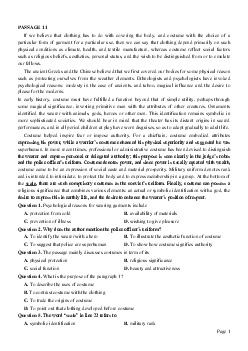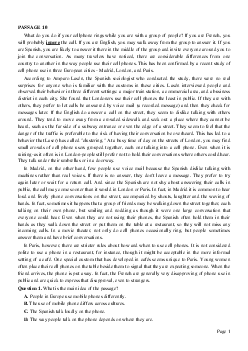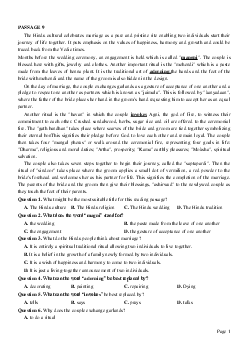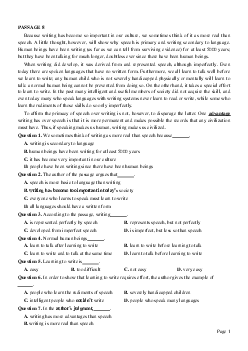


Preview text:
PASSAGE 3
The history of clinical nutrition, or the study of the relationship between health and how the body takes in
and utilizes food substances, can be divided into four distinct eras: the first began in the nineteenth
century and extended into the early twentieth century when it was recognized for the first time that food
contained constituents that were essential for human function and that different foods provided different
amounts of these essential agents. Near the end of this era, research studies demonstrated that rapid
weight loss was associated with nitrogen imbalance and could only be rectified by providing adequate
dietary protein associated with certain foods.
The second era was initiated in the early decades of the twentieth century and might be called "the
vitamin period. " Vitamins came to be recognized in foods, and deficiency syndromes were described. As
vitamins became recognized as essential food constituents necessary for health, it became tempting to
suggest that every disease and condition for which there had been no previous effective treatment might
be responsive to vitamin therapy. At that point in time, medical schools started to become more interested
in having their curricula integrate nutritional concepts into the basic sciences. Much of the focus of this
education was on the recognition of deficiency symptoms. Herein lay the beginning of what ultimately
turned from ignorance to denial of the value of nutritional therapies in medicine. Reckless claims were
made for effects of vitamins that went far beyond what could actually be achieved from the use of them.
In the third era of nutritional history in the early 1950's to mid-1960's, vitamin therapy began to fall into
disrepute. Concomitant with this, nutrition education in medical schools also became less popular. It was
just a decade before this that many drug companies had found their vitamin sales skyrocketing and were
quick to supply practicing physicians with generous samples of vitamins and literature extolling the virtue
of supplementation for a variety of health-related conditions. Expectations as to the success of vitamins in
disease control were exaggerated. As is known in retrospect, vitamin and mineral therapies are much less
effective when applied to health-crisis conditions than when applied to long-term problems of under
nutrition that lead to chronic health problems.
Question 1. What does the passage mainly discuss?
A. The stages of development of clinical nutrition as a field of study
B. The history of food preferences from the nineteenth century to the present
C. The effects of vitamins on the human body
D. Nutritional practices of the nineteenth century
Question 2. It can be inferred from the passage that which of the following discoveries was made during
the first era in the history of nutrition?
A. Certain foods were found to be harmful to good health.
B. Vitamins were synthesized from foods.
C. Effective techniques of weight loss were determined.
D. Protein was recognized as an essential component of diet.
Question 3. The word "tempting" is closest in meaning to . A. realistic B. necessary C. correct D. attractive
Question 4. It can be inferred from the passage that medical schools began to teach concepts of nutrition in order to
A. encourage medical doctors to apply concepts of nutrition in the treatment of disease Page 1
B. support the creation of artificial vitamins
C. convince doctors to conduct experimental vitamin therapies on their patients
D. convince medical doctors to participate in research studies on nutrition
Question 5. The word "Reckless" is closest in meaning to ? A. recorded B. irresponsible C. informative D. urgent
Question 6. The word "them" refers to A. effects B. vitamins C. claims D. therapies
Question 7. Why did vitamin therapy begin losing favor in the 1950's ?
A. Medical schools stopped teaching nutritional concepts
B. Nutritional research was of poor quality
C. The public lost interest in vitamins
D. Claims for the effectiveness of vitamin therapy were seen to be exaggerated.
Question 8. The phrase "concomitant with" is closest in meaning to A. in dispute with B. prior to C. in conjunction with D. in regard to
Question 9. The word "skyrocketing" is closest in meaning to
A. internationally popular B. increasing rapidly C. surprising D. acceptable
Question 10. The paragraph following the passage most probably discusses
A. Why nutrition education lost its appeal
B. Problems associated with undernutrition
C. The fourth era of nutrition history
D. How drug companies became successful ĐÁP ÁN 1-A 2-D 3-D 4-A 5-B 6-B 7-D 8-C 9-B 10-C
LỜI GIẢI CHI TIẾT Question 1:
Bài đọc từ đầu chia quá trình khoa học dinh dưỡng lâm sang thành 4 giai đoạn: “four distinct eras”, sau
đó lần lượt nói về các giai đoạn: the first, the second, the third… Question 2:
Người ta tìm ra rằng chỉ có cung cấp chế độ ăn có protein phù hợp mới chữa được bệnh sụt cân. Question 3: tempting: hấp dẫn realistic: thực tế necessary: cần thiết correct: đúng attractive: hấp dẫn Question 4:
Much of the focus of this education was on the recognition of deficiency symptoms. Page 2
Phần lớn trọng tâm của sự giáo dục này là việc phát hiện (chữa trị) các triệu chứng suy giảm. Question 5:
reckless: bất cẩn, khinh suất recorded: được ghi sẵn
Irresponsible: vô trách nhiệm Informative: giàu thông tin Urgent: khẩn cấp Question 6:
Reckless claims were made for effects of vitamins that went far beyond what could actually be achieved from the use of them. Question 7:
… extolling the virtue of supplementation for a variety of health-related conditions. Expectations as to the
success of vitamins in disease control were exaggerated. Những tuyên bố về tác dụng của liệu pháp
vitamin đã được phóng đại. Question 8: concomitant with: cùng với
in conjunction with: chung với
in dispute with: xung đột với
prior to: ưu tiên hơn (so với) Question 9:
internationally popular: phổ biến toàn cầu
increasing rapidly: tăng nhanh chóng surprising: ngạc nhiên
Acceptable: chấp nhận được Question 10:
Có 4 thời kì và đã có 3 thời kì đầu được nói đến lần lượt. Đoạn văn tiếp theo trong bài đọc hẳn sẽ nói về thời kì cuối cùng. Page 3




